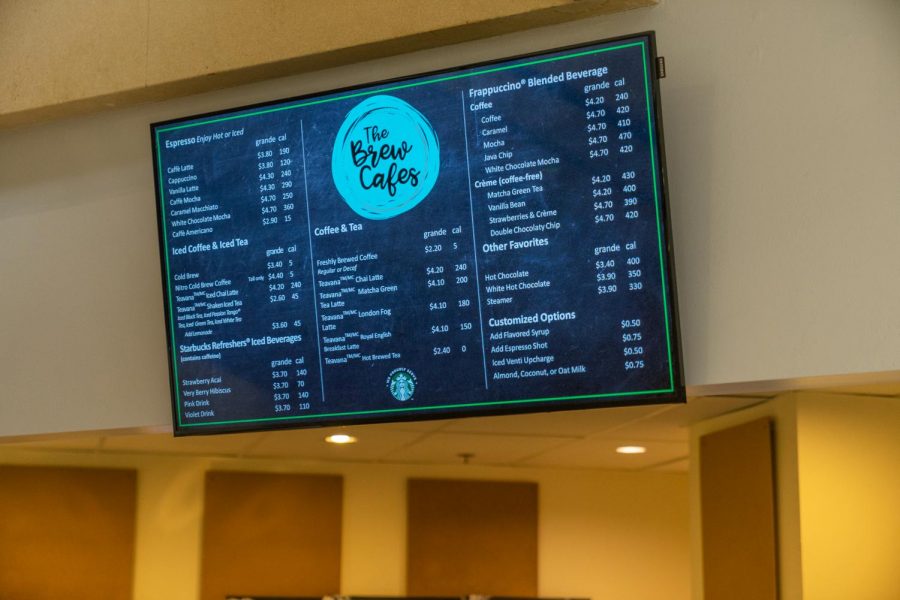I walk into The Brew and glance up at the menu board for a latte, but all I see are numbers. I find this disconcerting, considering I am a human who eats food and not data.
Displaying calories on menu boards appears to be a trend, but it isn’t just that — it’s a law. In 2014, the Food and Drug Administration rolled out new regulations per a mandate of the Affordable Care Act for food-selling businesses with 20 or more locations such as sit-down restaurants, fast food chains, convenience stores and movie theaters. These establishments were given until May 7, 2018 to comply. One of the regulations is that these businesses must list caloric values beside each item on the menu. Many smaller businesses with fewer than 20 locations, such as The Brew Cafes at Marquette, have still followed suit in implementing the regulations.
According to CNN, restaurants and organizations opposing this change cited concerns such as too much government oversight, and the high costs of analyzing nutritional information and making new menus. Supporters, on the other hand, see it as a way for the government to hold restaurants and other food vendors accountable for what they sell and to allow customers to make more mindful food purchases.
However, I want to know who is holding the government accountable when people with histories of eating disorders relapse because of this signage.
One of the chief symptoms, or byproducts, of an eating disorder is an extreme preoccupation with counting calories. Going out in public to eat — which can be extremely difficult and anxiety-inducing for those with or recovering from eating disorders — and being forced to look at the numbers can reintroduce disordered eating behaviors with which people with eating disorders try so hard not to engage.
A 2017 study — published in the International Journal of Eating Disorders — of 716 women found that women with anorexia or bulimia who were given menus with calorie information tended to order items with fewer calories while women with binge eating disorder tended to order more.
Displaying the caloric values of all menu items at restaurants and coffee shops is not only harmful to those struggling with eating disorders, body dysmorphia and self-image problems, but it also distorts what it means to be healthy. A 2019 Economist article details the complexities surrounding why calorie needs are so different from person to person and that the world’s sudden obsession with calories was a fearful response to obesity rather than an enlightenment about health.
I understand some people feel comfort in knowing the nutritional values in the foods they eat, or may want to lose weight, and thus knowing how many calories they are eating may seem like a necessary component of that goal. However, counting every calorie, especially in order to lose weight, is a skewed way of regarding health and can actually lead to eventual weight regain, according to a UCLA study.
The weight regain is not even what makes this practice of dieting harmful; it’s the implication that we should take up as little space and weigh as little as possible.
And yes — eating at restaurants like McDonald’s too frequently may be harmful to one’s health. However, knowing the effect of McDonald’s food on one’s overall health is the responsibility of the consumer. The FDA’s mandate seems to be saying that if neither the government nor the businesses are alerting them, customers will have no idea how many calories they are consuming. I agree that many people may not have the knowledge or access to this information, and I do believe calories and nutritional values should still be available for customers if they want to access them. Workers should inform curious customers or point them toward a website or pamphlet. The point is: it should be a choice.
Caloric values should not be forced onto people who do not wish to know them, and this doesn’t mean they don’t care about their health — they may actually be trying to protect themselves. Since obsessive calorie-counting is one of the chief behaviors associated with eating disorders, seeing calorie information will not aid those struggling with eating disorders in recovering. Someone in recovery may be trying to avoid falling back into a pattern of counting calories, but it seems impossible proven the ubiquity of menus that have already done the counting.
The FDA needs to prioritize eating disorders — one of which, anorexia, is the most fatal of mental illnesses — as a pervasive public health issue. The FDA shows a complete lack of awareness of eating disorder risk factors and triggers as well as a lack of consideration for the diversity of people’s nutritional needs.
We need a restructuring of the relationship between our bodies and food. People need to understand that our bodies are not supposed to look a certain way or weigh a certain amount and that the outdated 2,000-calorie-per-day suggestion does not reflect all humans’ diverse bodily needs.
Bodily diversity does not just include the varying sizes and shapes that constitute our population, but the varying kinds and amounts of foods we all need to fuel ourselves so we can feel healthy. By feeling healthy, I do not mean feeling skinny, nor curvy, nor anything specific. The FDA has the power to lead the charge in restructuring, yet its actions display a dangerous complacency.
This story was written by Emma Brauer. She can be reached at emma.brauer@marquette.edu.






